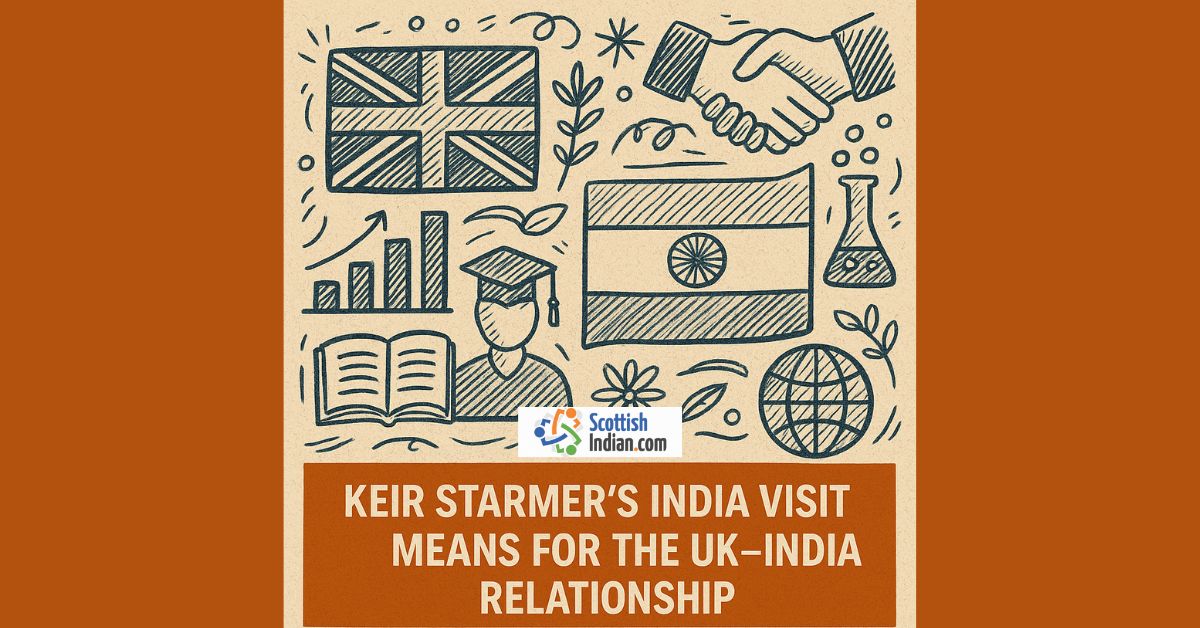When U.K. Prime Minister Keir Starmer landed in Mumbai on October 8, 2025, leading a 125-member delegation, it wasn’t just another diplomatic trip but it marked a turning point in UK–India relations. The visit symbolised a renewed partnership between two countries bound by history but focused on the future.
This high-profile delegation included business leaders, university representatives, and cultural envoys, underlining that the U.K. is looking to reset and rebalance its engagement with India after years of cautious diplomacy and stalled negotiations.
💼 1. A Trade Relationship at the Centre of Global Shifts
One of the main goals of Starmer’s visit is to revive the UK–India Free Trade Agreement (FTA) talks. The needful discussions that have seen multiple rounds without closure.
A successful FTA could:
- Reduce tariffs on goods such as Scotch whisky, automotive components, and textiles.
- Encourage investment in renewable energy, fintech, and technology sectors through the Department for Business and Trade – UK Government.
- Create jobs on both sides by expanding bilateral trade, which already exceeds £36 billion annually.
Both London and New Delhi view this deal as a chance to strengthen their positions amid changing global alliances, especially as each navigates new trade dynamics with the U.S. and China. For India’s perspective, the Ministry of Commerce and Industry – Government of India plays a key role in shaping trade strategy.
“India is no longer just a market — it’s a strategic partner,” Starmer reportedly said ahead of his visit, echoing the sentiment that future prosperity will depend on collaboration, not competition.
For readers interested in policy developments, the UK Department for Business and Trade provides regular FTA updates.
🎓 2. Education, Research, and Mobility on the Agenda
Alongside trade, education and research cooperation featured prominently during the visit. Universities from both countries are exploring new partnerships under initiatives such as the UK–India Education and Research Initiative (UKIERI) to:
- Expand joint degree programmes and research exchanges.
- Simplify student visa procedures.
- Support UK campuses in India and vice versa.
Indian students already represent one of the largest international student groups in the U.K., and post-study work rights remain a key concern. Starmer’s administration has signalled that student mobility will be protected, ensuring the U.K. remains a welcoming destination for global talent.
The discussions also opened doors for new scholarships and dual-recognition degrees, bridging the gap between British academic frameworks and India’s growing innovation ecosystem.
For details on studying and working in the U.K., visit Study UK – British Council.
🌍 3. The Diaspora: A Bridge of Shared Values
The 1.8-million-strong Indian diaspora in the U.K. continues to play a vital role in connecting the two nations — economically, culturally, and politically.
During his trip, Starmer met with Indian business leaders and cultural organisations, recognising the diaspora’s contributions in fields ranging from healthcare to entrepreneurship. Many of these discussions took place with key partners such as FICCI – Federation of Indian Chambers of Commerce and Industry and CII – Confederation of Indian Industry.
The symbolic warmth of this visit was marked by respectful cultural gestures and collaborative spirit which underscores how soft power and people-to-people ties can often succeed where hard politics stall.
As one Indian business chamber put it, “The diaspora is the heartbeat of UK–India relations.”
Explore more stories of the diaspora community in Scotland on our ScottishIndian Blogs.
🔍 4. A Modern Partnership, Rooted in Respect
This visit represents more than policy negotiations. It’s a reset in tone.
Both governments now seek a relationship defined not by colonial legacies, but by mutual respect, shared growth, and cultural understanding.
Areas expected to see deeper cooperation include:
The next phase of the partnership will depend on how effectively both sides implement what was discussed in Mumbai. Which is not just in trade offices, but in classrooms, labs, and communities.
Keir Starmer’s India visit was both symbolic and strategic. It showed that the future of UK–India relations lies not just in government agreements, but in human connections. Thus, including students studying abroad, families bridging continents, and businesses innovating together.
As the U.K. and India move into a new era of partnership, this visit may well be remembered as the moment both nations began writing a more collaborative, confident chapter of their shared story.






